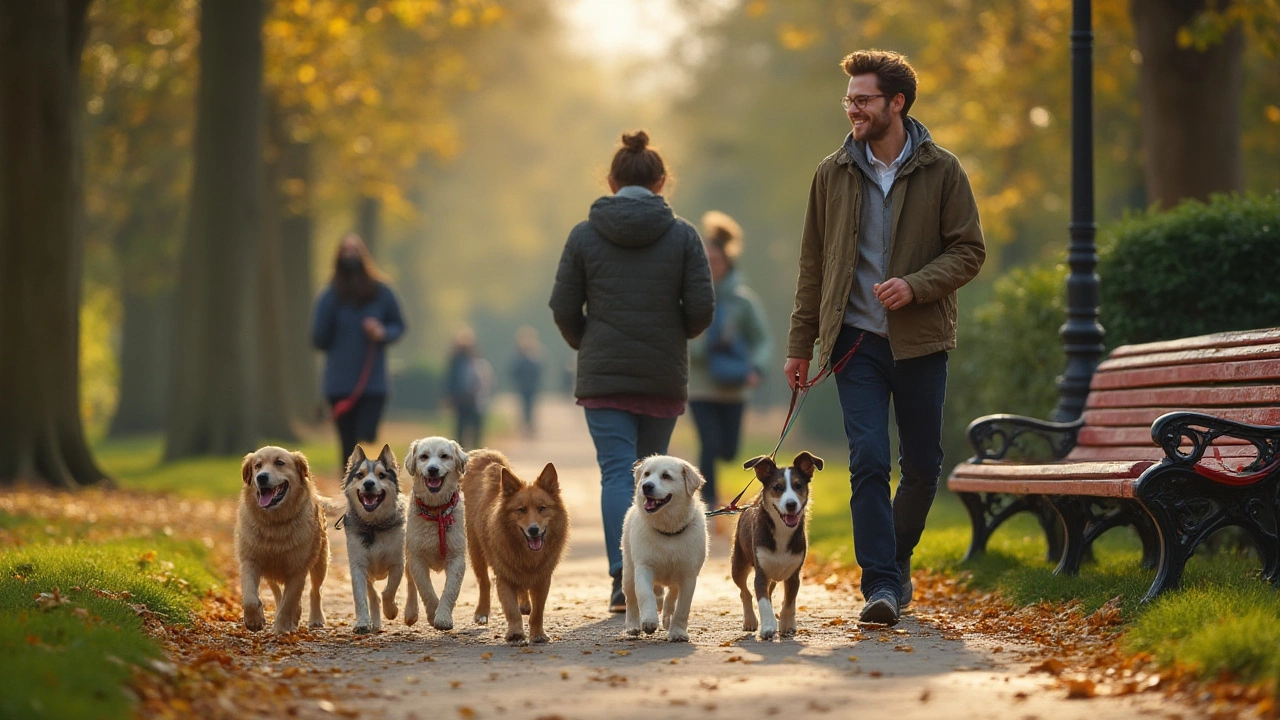Have you ever wondered who’s actually walking your dog when you’re not around—or what it’s really like for them? The world is full of guilty pet parents watching through doorbell cams as their dog waits by the window for hours. Outsourcing those walks seems like a no-brainer, but is it really a smart choice or just another trend in the booming pet industry? The answer's not as simple as you’d think. If you live in a busy city and work late, dog walkers might feel like a lifeline. But let’s pull back the curtain and see what hiring one really means for your dog—and for you.
The Real Upside: Why Dog Walkers Are a Lifesaver For Modern Pet Owners
Let’s be honest. Most of us have experienced that nagging guilt after a twelve-hour workday, when the leash hangs untouched and your pup’s eyes are searching for action. A good dog walker doesn’t just help your dog burn off energy—they keep your dog’s day interesting, alleviate boredom, and limit destructive behavior. Studies, like one published by the Journal of Veterinary Behavior in 2022, show that regular walks with different people actually boost a dog’s adaptability and confidence around strangers.
Some dogs just need more stimulation than a tired human can offer every day. Herding breeds, young hounds, and working dogs pretty much have "unlimited battery mode." Regular walks with a professional can fill the exercise and social needs most owners (myself included!) can’t always match. Plus, a dog walker can help spot early signs of health or behavioral issues, which you might miss if you’re always in a rush.
Ever notice your dog gobbles food less anxiously when they’ve been out? It’s not your imagination. A 2023 study by the Royal Society for the Prevention of Cruelty to Animals (RSPCA) confirmed that regular daytime walks can actually reduce the risk of separation anxiety and related digestive problems. Dogs crave connection. By breaking up their day, a midday walk can prevent everything from chewed-up couches to complaining neighbors.
And let’s not overlook the emergency factor. Life happens—unexpected overtime, car trouble, or sick days. One of the best things my husband, Gavin, and I did was scout out vetted walkers for "just in case." Now, if life throws a curveball, we have a trusted backup plan and peace of mind.
| Benefit | Detail |
|---|---|
| Reduction in behavioral problems | 70% of owners see less destructive behavior with regular walks |
| Decreased separation anxiety | Daily walks drop the chance of anxiety by up to 40% |
| Better physical health | Dogs walked daily are 45% less likely to be overweight |
| Socialization gains | Regular walker = easier vet visits and less leash reactivity |
So when is a dog walker a must-have rather than a luxury? The answer is simple: If you’re gone more than six hours a day and your dog is under three, aging, extra energetic, or prone to separation distress, having a walker can be life-changing.
Potential Downsides: What You Risk When Outsourcing Walks
Sounds dreamy, but there’s a flip side. Handing over your keys and your dog isn’t risk-free, even if you pay top dollar. Not every walker is a "dog person." Some are just college students hustling for cash, others are overbooked multitaskers rushing the next dog drop-off. And even among the pros, distractions happen. There are viral videos of walkers glued to their phones, or worse, skimping on the promised walk time.
That’s not the only thing you should keep on your radar. Accidents do happen—escaped dogs, lost tags, unleashed dog fights. One Pet Industry survey from 2024 found that 17% of dog owners who hired walkers reported at least one safety incident over a two-year period.
Another concern: consistency. Dogs love routine, and an ever-changing parade of walkers can mean unpredictable experiences. This could actually undo the trust and stability you’re hoping to provide. If you’re not careful about setting expectations, your dog could end up learning bad leash manners, picking up nervy habits, or developing anxiety around strangers.
Also, does your dog have special medical needs or quirky triggers? Don’t assume all walkers are trained for everything. Some aren’t comfortable administering meds, dealing with high-strung pups, or handling reactivity toward other dogs. Always ask, and never gloss over these details.
Not to scare you, but home privacy is another issue. You’re giving someone access to your keys or codes. Legit companies are insured and background-check their walkers, but it’s not universal—so check, double-check, and set up boundaries. You might want cameras, or to sync schedules with neighbors for shared oversight.
As for cost, services vary. In major U.S. cities in 2025, a 30-minute walk runs anywhere from $20 to $35. If you want private walks, daily texts, or medication help, expect that number to climb. That adds up fast, especially on a tight budget. If you can’t afford it regularly, it’s worth looking into "walk-sharing," neighborhood dog-walking co-ops, or flexible schedules.
If you catch a walker shortchanging your dog or you sense your dog’s anxiety actually increasing, it’s time to reassess. Pay attention to changes in mood: if your dog suddenly resists leashing up or acts nervous after a walk, don’t brush it off. Trust your instincts—dogs tell us plenty, even without words.
"Hiring the right walker is a commitment. Knowing your dog’s needs and doing your due diligence can set everyone up for a safe, rewarding experience." — Rachel Rodgers, Certified Professional Dog Trainer (CPDT-KA)

How To Pick a Great Dog Walker (And What to Watch For)
Diving into hundreds of profiles on Rover or Wag can feel overwhelming, so here’s how to separate the gems from the duds. First, start with referrals from friends or your local vet’s office. Word-of-mouth is gold. Then, move on to trial walks: introduce the walker to your dog before you ever hand over your house key. Watch for chemistry, calm, and the walker’s ability to handle unexpected situations—like if your dog refuses to go out in the rain or lunges at a passing squirrel.
- Ask for credentials: Are they insured and bonded? Any first-aid certification?
- Do a background check. Legit pros won’t blink at this.
- Request references. And actually call them.
- Be up-front about your dog's quirks or health needs. If your dog takes daily meds or has leash fears, test the walker’s reactions.
- Set clear schedules, routes, and expectations. Will they walk solo, or in a pack? Are treats allowed? How will you get updates—a walk log, photos, or texts?
- Look for walkers who notice details, not just the basics. An experienced walker can spot a limp, a developing hot spot, or changes in appetite faster than an app will tell you.
A good contract helps too, laying out prices, service windows, and what happens in emergencies. Some suggest a GPS walk tracker, especially if you work odd hours or travel. Nothing replaces peace of mind.
If you’re worried your dog might not like it, start with drop-in visits or walks with you tagging along. Some pets need that extra "sniff test" before they trust a new face. Watch your pet’s body language after a walk—happy tail, relaxed ears, gentle excitement? Or are they hiding and out of sorts?
And don’t forget to listen to your gut. If anything feels off, keep looking—it’s your dog’s emotional and physical security on the line.
| Red Flag | What It Might Mean |
|---|---|
| Poor communication | Lack of updates, missed texts, vague notes—consider someone else |
| Too many dogs at once | Your dog may not get enough attention or control |
| Dismisses your concerns | They’re unlikely to handle emergencies well |
| No proof of insurance/bonding | Big risk to your home and pet |
Tips For Making the Most Out of Dog Walking Services
So you’ve hired a dog walker—how do you get the best for your pet (and your bank account)? It starts with clear communication: spell out what you expect, and update the walker often. Is your dog using a new collar? Has your dog’s health changed? Even small things, like a neighbor's new puppy or construction on your block, might affect the daily routine.
Make things seamless by prepping your dog for the first few visits. You might try a short sniff-and-greet with the walker in your home or on the usual route. Keep walks short at first if your dog is shy, or join for the initial few times. Trust grows with time and familiarity, not just contracts.
Have a designated leash, harness, and towel ready by the door. Leave detailed notes: emergency numbers, your vet’s number, and backup contact info. I keep a little "dog book" by the leash with photos, medical info, and feeding tips. If your dog has specific triggers—squirrels, skateboards, men in hats—write it all down. They’ll thank you for it.
After the first month, take a time-out to assess. Has your dog’s energy improved? Is destructive behavior down? Check your dog walker’s updates—any skipped days or weird incidents should be flagged and discussed. A great walker will gladly answer your questions and adjust as needed.
If cost is a concern (and when isn’t it?), talk about batching walks with trusted neighbors. Many app-based companies let you coordinate group walks, which can slash costs. Some cities now offer co-op walking setups, letting families take turns on dog duties throughout the block. It saves money, builds community, and keeps dogs socialized.
And don’t forget to say thanks. Walkers notice when you care about their work, and gratitude (or a small tip, if you can) helps build a loyal relationship. Celebrate the wins—like a new milestone in leash-training or behavior breakthroughs—with praise and maybe a coffee on those rainy, muddy days.
Remember, the whole idea is to make life easier and happier for your dog and stress-free for you. The right walker doesn’t just fill a time slot—they become part of your dog’s trusted circle. When you see your pup wagging eagerly to greet their walker, you’ll know you made the right call.
For busy lives or challenging pups, investing in reliable dog walking isn’t just about "exercise." It’s about connection, understanding, and giving your four-legged best friend a daily adventure—rain, shine, or the occasional chewed-up shoe.
